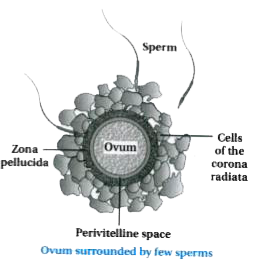Where does fertilisation take place in human beings? What changes occur in egg cell (ovum) during fertilisation?
Text Solution
During copulation (coitus) semen is released by the penis into the vagina.
The motile sperm swim rapidly, pass through the cervix, enter into the uterus and finally reach the junction of the isthmus and ampulla of the fallopian tube.
The ovum released by the ovary is also transported to the ampullary isthmic junction where fertilisation takes place.
Fertilisation can only occur if the ovum and sperms are transported simultaneously to the ampullary-isthumic junction. This is the reason why not all copulations lead to fertilisation and pregnancy.
The process of fusion of a sperm with an ovum is called fertilisation.
During fertilisation a sperm comes in contact with the zona pellucida layer of the ovum and induces changes in the membrane that block the entry of additional sperms. Thus it ensures that only one sperm can fertilise an ovum.
The secretion of acrosome help the sperm enter into the cytoplasm of the ovum through zona pellucida and the plasma membrane. This induces the meiotic division of the secondary oocyte.
The second meiotic division is also unequal and results in the formation of a second polar body and a haploid ovum (ootid).
Soon the haploid nucleus of the sperm and that of the ovum fuse together to form a diploid zygote.

|
Topper's Solved these Questions
- HUMAN REPRODUCTIONBook:KUMAR PRAKASHANChapter:HUMAN REPRODUCTIONExercise:SECTION-B (DIFFERENCE / SCIENTIFIC REASONS)
Explore 6 Videos
- HUMAN REPRODUCTIONBook:KUMAR PRAKASHANChapter:HUMAN REPRODUCTIONExercise:SECTION-B (GIVE SCIENTIFIC REASONS)
Explore 6 Videos
- HUMAN HEALTH AND DISEASE Book:KUMAR PRAKASHANChapter:HUMAN HEALTH AND DISEASE Exercise:Section - F (Multiple Choice Question) (MCQs Asked In Competitive Exam))
Explore 33 Videos
- MICROBES IN HUMAN WELFARE Book:KUMAR PRAKASHANChapter:MICROBES IN HUMAN WELFARE Exercise:SECTION - F MULTIPLE CHOICE QUESTIONS(MCQS ASKED IN COMPETITIVE EXAM)
Explore 56 Videos
Similar Questions
Knowledge Check
Where does fertilisation takes place in earthworm ?
AVasa deferentiaBSpermathecaeCCocoonDClitellumFertilisation in human beings occurs in
AIsthmusBAmpullary - isthmic junctionCUterusDInfundibulumThe fertilisation in mammals including human beings takes place in
AVestibuleBVaginaCFallopian tubesDUterus
Where does fertilisation normally take place in a human female?
View SolutionHow does fertilisation take place in human beings ? Fertilisation occurs once in a month. Comment.
View SolutionThe fertilisation in mammals including human beings takes place in
View SolutionIn human beings the fertilisation occurs in the
View SolutionIn human beings the fertilisation occurs in the
View Solution

